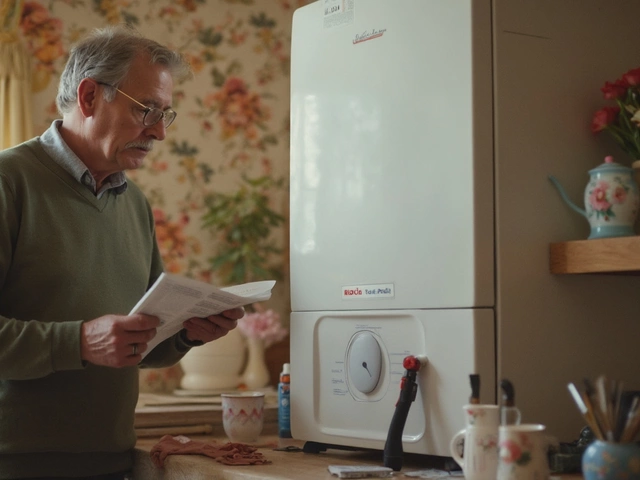Oven Element Tester
Test Your Oven Element
Enter your multimeter reading to check if your oven element is working properly.
Important Safety Note: Always turn off power at the circuit breaker before testing. Never work on live electrical components.
If your oven won’t heat up, or it’s taking forever to cook food, chances are your heating element has gone out. It’s one of the most common oven failures - and it’s usually simple to fix. You don’t need to be a technician to check it yourself. All you need is a little patience, a flashlight, and maybe a multimeter if you’re comfortable using one.
What does a blown oven element look like?
The heating element in your electric oven is the metal coil at the top or bottom of the oven cavity. When it’s working, it glows bright orange-red when the oven is on. If it’s blown, you’ll often see obvious signs: black spots, cracks, bubbles, or sections that look burnt or broken. Sometimes, the coil is sagging or has fallen off its mount. If you see any of this, the element is dead.
But here’s the catch - not all blown elements look obvious. Sometimes, the break is tiny, hidden inside the coil, or the element looks fine from the outside but isn’t conducting electricity. That’s why a visual check isn’t always enough.
Does the oven turn on but not heat?
If your oven lights up, the fan runs, the display works, but the inside stays cold, that’s a textbook sign of a failed heating element. The control board is sending power, but the element isn’t responding. This rules out issues with the thermostat or timer. It’s almost always the element.
Try this quick test: turn the oven on to 180°C and watch the element for 10 minutes. If it doesn’t glow at all - even a faint red - it’s not working. If it glows only in spots, or flickers, that’s also a sign of failure. A healthy element glows evenly from end to end.
Use a multimeter to confirm
If you’re unsure after the visual and glow test, grab a multimeter. You can buy one for under $30 at any hardware store. Turn off the power at the circuit breaker before you start. Safety first - no exceptions.
Remove the element by unscrewing the two or three mounting screws holding it in place. Pull it forward gently - you don’t need to disconnect wires yet. Set your multimeter to ohms (Ω), and touch one probe to each terminal on the back of the element. A good element will read between 20 and 120 ohms, depending on the model. If it shows “OL” (open loop) or zero, the element is blown.
Most oven elements for standard home ovens run around 30-50 ohms. If you’re not sure what’s normal for your model, check the manufacturer’s manual or look up the part number online. A reading outside that range means it’s time to replace it.

Why do oven elements blow?
Elements don’t just die for no reason. They wear out over time - most last 5 to 10 years. But certain habits speed up the process:
- Spills that bake onto the element - especially sugary or fatty messes - cause hot spots that weaken the metal.
- Using the self-clean cycle too often. The high heat (over 500°C) puts serious stress on the element.
- Power surges. If you’ve had recent lightning storms or flickering lights, that could’ve fried the element.
- Physical damage. If someone bumped the oven or cleaned too aggressively with metal tools, they could’ve cracked the coil.
In Brisbane’s humid climate, moisture can also get trapped inside the oven over time. That doesn’t directly kill the element, but it can cause corrosion on the terminals, which leads to poor connections and overheating.
What else could be wrong?
Before you buy a new element, rule out other common issues:
- Thermostat: If it’s faulty, the oven might not get to the right temperature. But the element will still glow - you’ll just see inconsistent heating.
- Thermal fuse: Some ovens have a safety fuse that cuts power if things overheat. If it’s blown, the oven won’t heat at all. It’s usually located near the element or on the back panel. Testing it requires a multimeter too.
- Wiring or terminals: Loose, burnt, or corroded wires can stop power from reaching the element. Check the connections at the back of the element - look for black marks or melted plastic.
- Control board: Rare, but possible. If the board doesn’t send power to the element, nothing happens. But this usually affects multiple functions, like the broil element too.
If both the top and bottom elements are dead at the same time, it’s more likely a control board or fuse issue. If only one element is out, it’s almost always the element itself.
How much does it cost to replace?
Replacing an oven element is one of the cheapest oven repairs you can do. The part itself usually costs between $30 and $80, depending on your oven brand. Bosch, Siemens, and Samsung parts tend to be on the higher end. Generic replacements work fine for most models.
If you do it yourself, you’re only paying for the part and maybe a new screw or two. If you hire a technician, expect to pay $100-$180 including labour. That’s still cheaper than buying a new oven - unless your appliance is over 12 years old.

How to replace it
Replacing the element is a 30-minute job. Here’s how:
- Turn off the power at the circuit breaker.
- Remove the oven racks.
- Unscrew the mounting screws holding the element in place - usually two at the back.
- Gently pull the element forward until you see the terminals.
- Disconnect the wires by pulling them off the terminals. Take a photo first so you know which wire goes where.
- Install the new element, reconnect the wires, and screw it back in.
- Turn the power back on and test it.
Don’t force the wires. If they’re stiff, wiggle them gently. If they’re brittle or cracked, replace them too. Use heat-resistant wire nuts if you need to splice new wires.
What to do if you’re not comfortable
If you’re unsure about working with electricity, or if your oven is built into cabinetry and hard to access, call a professional. It’s not worth risking a shock or fire. Look for a technician who specializes in oven repair - not just general appliance fixes. Ask if they carry the part for your brand. Many will come out, diagnose it, and replace it all in one visit.
Prevent future failures
To make your next element last longer:
- Clean spills right away - don’t let them bake on.
- Avoid using the self-clean cycle more than twice a year.
- Use oven liners or baking trays to catch drips.
- Check the terminals every year for corrosion. Clean them with a wire brush if needed.
- Install a surge protector for your oven if you live in an area with unstable power.
Most people don’t think about oven maintenance until something breaks. But a quick annual check can save you a lot of hassle - and money.
Can a blown oven element cause a fire?
A blown element itself won’t start a fire, but if the wires or terminals are damaged or corroded, they can overheat and spark. That’s why it’s important to turn off the power before inspecting or replacing the element. If you smell burning plastic or see smoke coming from the back of the oven, shut off the circuit breaker immediately and call an electrician.
Why does my oven heat unevenly after replacing the element?
If the new element is installed crooked, or if the wires aren’t connected properly, it might not heat evenly. Double-check that the element is seated flat against the back wall and that both terminals are securely attached. Also, make sure you got the right replacement part - some ovens have different wattages for top and bottom elements. Using the wrong one can cause uneven cooking.
Can I use the oven if one element is blown?
If the bottom element is blown and you’re using the oven for broiling (top element only), you might get by for a short time. But most modern ovens need both elements to function properly - especially for baking. Using the oven with a broken element can strain the remaining one and cause it to fail sooner. It’s better to fix it before you risk more damage.
How long do oven elements usually last?
Most oven elements last between 5 and 10 years. Heavy use, frequent self-cleaning, and spills can shorten that lifespan. In homes where ovens are used daily, like in Brisbane’s busy households, elements often wear out closer to the 5-year mark. If your oven is over 10 years old and the element has never been replaced, it’s likely due for a new one.
Do I need to replace both the top and bottom elements at the same time?
No, unless both are faulty. Most ovens have separate elements for baking (bottom) and broiling (top). Replace only the one that’s blown. However, if one element failed after 8 years, the other is probably close behind. Some people choose to replace both at once to avoid a second repair soon after - it saves time and labour if you’re doing it yourself.
If your oven isn’t heating and you’ve checked the element, thermostat, and wiring - and everything looks good - the issue might be deeper. But in 9 out of 10 cases, it’s the element. Don’t overcomplicate it. Start with the simplest fix. It’s usually the cheapest, fastest, and most effective solution.





